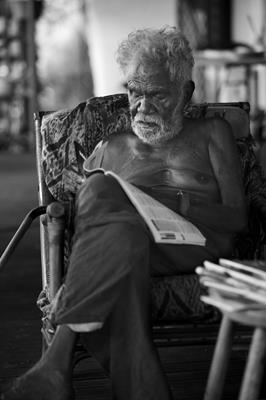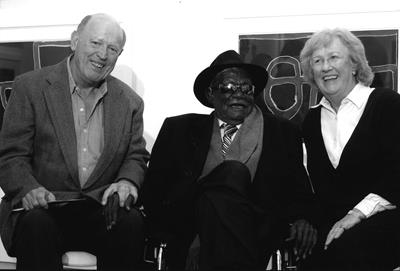PADDY BEDFORD
THE LAVERTY COLLECTION - PART III
5 April 2017, Sydney
PB-Maestro_sharpened.jpg

Paddy Bedford (c.1922-2007), also known by his Gija name Nyunkuny or perhaps even more by his Gija nickname Goowoomji, is considered to be one of the greatest indigenous Australian artists. His art transcends local and cultural constraints in a convincing and exciting way and appeals to international audiences and contemporary art collectors alike. In his oeuvre his knowledge as a respected lawman and his experiences travelling country as a stockman all merge in powerful iconic images.
Bedford's work has been shown in a number of national and overseas exhibitions. He was one of eight artists chosen to present a commissioned work to the Musée du quai Branly in Paris (2006). In 2006-2007 Bedford was honoured with a major retrospective of his work at the Museum of Contemporary Art in Sydney. On an international level a large individual exhibition of his work took place at AAMU – Museum of contemporary Aboriginal art in Utrecht (the Netherlands) in 2009-2010. Other European art galleries to incorporate his work in exhibitions included the Ludwig Museum in Cologne and the Musée d'Acquitaine in Bordeaux. National and international collections, including the Metropolitan Museum of Art in New York hold work by Bedford.
Paddy Bedford started painting with modern materials in 1998, the year that Rover Thomas passed away. Although Bedford was four years senior to Thomas, he spearheaded a second wave of East Kimberley painters that found culmination in the Jirrawun Aboriginal Art Corporation of which he was one of the founding members. Colin and Elizabeth Laverty, through a long-time friendship with Tony Oliver, Jirrawun’s artistic director and former gallery owner, were able to follow developments at Jirrawun from the very beginning. They were the first collectors to acquire Bedford’s work and remained true supporters of Bedford and the arts cooperative.
The untitled work on plywood (Lot 6) dating from 1998 belongs to the earliest works that Bedford ever produced. It bears the Jirrawun catalogue number PB1998.03 and is one of the first four paintings by this artist that were acquired by the Laverty’s during their visit in 1998 to the Jirrawun Arts shed in Rugun (Crocodile Hole). Tony Oliver had found these masterpieces on the floor in a dark room in the house of Chocolate Thomas in Warmun (Turkey Creek) while the artist was standing outside. Not long after, Bedford would move to Kununurra to paint new work on composition board and canvas.
The irregular shapes of these early panels are characteristic of the found materials from the local tip Bedford initially used as supports. In this painting the artist is clearly experimenting with form, line and composition. While the imagery is still evocative of the characteristic East Kimberley paintings, Bedford’s unfailing sense for strong composition and bold imagery starts to emerge in the use of powerful lines and oval shapes. There is an immediate freshness in this picture that reflects a sincere joyfulness in working with the new medium and an inspired urge to paint. This panel announces the larger-scale paintings on canvas as well as the Jirrawun suite of works on paper now in the Yirribana Collection at the Art Gallery of New South Wales.
The brash playfulness of the composition in this panel is also manifest in both gouaches presented in this auction. In the first untitled gouache dating from 2003 (Lot 7), Bedford’s natural predilection for an outspoken formal language becomes apparent. Forms and lines open and close the picture as a form of écriture automatique (automatic writing). Although the black in the picture belongs to the Crescent board support, it is fully integrated in the image. The balanced composition is the result of an instinctive search for harmony.
In later gouaches, like in the untitled work dating from 2004 (Lot 8), colour gradually assumes a greater role. Colour – which in conventional East Kimberley palette is limited to ochre tones ranging from red to yellow, and black and white – assumes an equal part in the composition. The colours in this particular work bring to mind Mondrian and the Dutch De Stijl movement. In this striking picture, exposing Bedford’s genius in composition, the primary colours red, yellow and blue contrast sharply with the more 'earthly' black and grey colour plane. It is tempting to observe the fortuitous meeting of two art worlds, one Indigenous Australian and one European. Although the gouache and pencil works on paper are fully fledged, mature works on their own, they can at least in part be read as studies for the larger paintings on panel or canvas.
Col Liz & Paddy.b.w.jpg

Mad Gap, 2005 (Lot 9), despite its size, is a relatively sober picture yet Bedford paints in surprising vivid brushstrokes. In these the roughness of the former stockman can be recognised. Pigments on the canvas emanate a shimmering quality which is accentuated by the brushstrokes. This luminosity or transparency in his application, which seem to develop in later years, is a direct result of his use of the wet-on-wet technique, which requires a fast way of working. While this technique has been popular with many European artists throughout history, it was never widely spread amongst indigenous Australian artists. Paddy Bedford not only experimented with this method, which was probably informed by the practice of painting with gouaches, but also put it to use as a manner to add depth of meaning and dynamism to his painted narratives.
Mad Gap is the name that the Europeans gave to Gooweriny, meaning ‘place of the cypress pine’. This area, which is also known as Jarlaloon, is in the southern part of Bedford’s mother country. Large hills near the river are prominent features in this region. In a large cave in the side of one of those hills people used to shelter in pre-colonial times. It is said that a joowarri (a kind of spirit being) haunts this area. The joowarri comes out at night to take away something that was caught by someone and left in a tree. The ngarranggarni story associated with this place relates to a goanna that was swallowed by a crocodile.
As in other paintings, different narratives converge in this picture. Ngarranggarni – the Gija word for the Dreaming – stories intersect with recent colonial history. Considering that in Aboriginal cosmology there is a profound, intrinsic relationship between human and country, these pictures are highly autobiographical of the artist. As Tony Oliver, art director of Jirrawun, writes in the preface to the catalogue of Paddy Bedford’s major retrospective exhibition at the Museum of Contemporary Art, Sydney in 2006, ‘These rocks and waterholes – these symbols weighted or weightless in space – appear in dialogue with each other and as in life are in constant dialogue with the artist.’
The compelling imagery of Mad Gap reconnects with the initial interest the Lavertys had in bold gestural abstraction. However, the powerful brushstrokes in this picture invoke a deep sense of country rather than painterly abstraction. Mad Gap opens and reopens the picture, constantly redefining borders and delimitations of the composition. Although using a seemingly abstract language, the shapes bear resemblance with the natural features of the East Kimberley landscape. While the two black conic motives are reminiscent of the alternating hilly and flat country, lines suggest a planar view of roads, thus implying the dual, simultaneous perspective so typical for East Kimberley painting. Fine fragile lines contrast surprisingly well with the white expanse and the conic shapes.
Mad Gap is a wonderful example of organic geometry. It is as simple and evident in its balanced composition as it is complex in the stories it tells. This duality is also reflected in the equality of importance between shapes and lines in the picture’s composition. While physical forms prevail in the painting, a great poetic sensitivity resonates throughout the picture. Behind the composition’s subtle harmony lurks a learned and intrinsic knowledge of the land and its creation stories. This congruity of powerful physicality and great sensitivity, which in the Western world often connote respectively the masculine and the feminine, is perhaps the essence of Bedford’s imagery.
GEORGES PETITJEAN
RETURN TO CATALOGUE